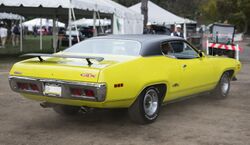Engineering:Plymouth GTX
| Plymouth GTX | |
|---|---|
 1970 Plymouth GTX | |
| Overview | |
| Manufacturer | Chrysler Corporation |
| Production | 1966–1971 (44,178 units) |
| Assembly | St. Louis, Missouri, United States |
| Body and chassis | |
| Class | Muscle car |
| Layout | FR layout |
| Platform | B-body |
The Plymouth GTX is an automobile introduced as the Belvedere GTX in 1967 by the Plymouth division. It was positioned as a mid-sized upscale-trimmed performance muscle car through the 1971 model year.
1967
| First generation | |
|---|---|
 | |
| Overview | |
| Also called | Plymouth Belvedere GTX |
| Production | 1967 |
| Body and chassis | |
| Body style |
|
| Related | Dodge Charger Plymouth Belvedere Plymouth Satellite |
| Powertrain | |
| Engine | 426 cu in (7.0 L) Hemi V8 440 cu in (7.2 L) RB V8 |
| Transmission | 4-speed manual 3-speed automatic |
| Dimensions | |
| Wheelbase | 116.0 in (2,946 mm) |

The GTX was based on the Belvedere, and was differentiated by a blacked out grille and special rear fascia, fiberglass simulated hood scoops with optional racing stripes, a chrome "pop-open" fuel filler cap, and a tachometer mounted on the center console.[1]
The GTX was positioned as a "gentleman's muscle car".[2] Standard was Plymouth's 440 cu in (7.2 L) V8 engine called the "Super Commando 440" rated at 375 hp (280 kW). Optional was Chrysler's 426 cu in (7.0 L) Hemi. A heavy duty suspension system was also standard.
Performance
| Model | 0-60 mph | 1/4 mile time | Source |
|---|---|---|---|
| 1967 440 | 6.5 seconds | 15.2 seconds at 97 mph (156 km/h) | [2] |
| 1967 426 Hemi | 4.8 seconds | 13.5 seconds at 105 mph (169 km/h) | [2] |
1968-1970
| Second generation | |
|---|---|
 1968 Plymouth GTX | |
| Overview | |
| Model years | 1968–1970 |
| Body and chassis | |
| Body style |
|
| Platform | B-body |
| Related | Dodge Charger Plymouth Belvedere Plymouth Satellite |
| Powertrain | |
| Engine | 426 cu in (7.0 L) Hemi V8 440 cu in (7.2 L) RB V8 |
| Transmission | 4-speed manual 3-speed automatic |
| Dimensions | |
| Wheelbase | 116.0 in (2,946 mm) |
| Length | 202.7 in (5,149 mm) |
| Width | 76.4 in (1,941 mm) |
| Height | 54.7 in (1,389 mm) |
1968

Chrysler introduced major changes in the design of the 1968 model Plymouth B-bodies and the GTX was given a completely new look. A new hourglass body replaced the previous rectilinear design. The high performance 440 was standard in the GTX as was the TorqueFlite automatic transmission, while it was an extra cost option in the Road Runner. The GTX used the Sport Satellite trim and was offered in two body styles, a two-door convertible and a two-door hardtop (no B-pillar). All featured dual horizontal "racing stripes" on the lower sides ending with a GTX emblem ahead of the rear wheel openings.
The GTX was positioned to be an upscale model of the Plymouth Road Runner by adding luxury to performance.[3]
1969

In 1969, the GTX's sales dropped when the Road Runner was also offered in a convertible body style. The GTX received minor cosmetic changes to the tail lights and grille, as well as the side marker lights. An optional "Air Grabber" hood (standard on Hemi-engined cars) featured functional openings on both sides of the hood that were controlled from the dash.[4]
The 1969 GTX had standard black lower-body side paint in place of the previous stripes. The standard 440 V8 was still rated at 375 hp (280 kW). This was the last year that the convertible model was available on the GTX. Total production was 701 GTX convertibles in 1969. Of those, eleven were equipped with the 426 Hemi; four were 4-speeds and seven had TorqueFlite automatics.
1970
The 1970 GTX received a minor redesign with a new grille and rear taillights. Sales were low as the car did not look much different from the Road Runner. Stylists made the lines smoother, and a "power bulge" hood was introduced, as well as non-functional rear-brake air scoops. The convertible body style was no longer available. The Air Grabber hood returned, but instead of having two narrow openings running length-wise as in 1969, it had one opening scoop located on the power bulge. The GTX was available with the standard 440 four-barrel carburetor. Optional were the 440+6 barrel (three 2-barrel carburetors) and the 426 Hemi. In keeping with the GTX marketing strategy, the 1970 model included many standard features.
The only other performance luxury model in Plymouth's lineup was the full-size Sport Fury GT, built on the C-Body platform. The GT was added to the lineup in 1970.
1971
| Third generation | |
|---|---|
 1971 Plymouth GTX | |
| Overview | |
| Model years | 1971 |
| Body and chassis | |
| Body style | 2-door hardtop |
| Related | Dodge Charger Dodge Coronet Plymouth Road Runner Plymouth Satellite |
| Powertrain | |
| Engine | 426 cu in (7.0 L) Hemi 426 V8 440 cu in (7.2 L) RB 440 V8 |
| Transmission | 4-speed manual 3-speed automatic |
| Dimensions | |
| Wheelbase | 115.0 in (2,921 mm) |
| Length | 203.2 in (5,161 mm) |
| Width | 79.1 in (2,009 mm) |
| Height | 52.9 in (1,344 mm) |

The B-body was redesigned for 1971 and featured rounded "fuselage" styling with a raked windshield, hidden cowl, and a loop-type front bumper around a deeply inset grille and headlights. This was the final year for the GTX as a stand-alone model. The convertible body style was dropped.

Engine choices were 440 four-barrel, 440 with three two-barrels (Six Pack), and 426 Hemi. Emission restrictions such as lower compression ratios and faster-acting choke operation lowered the base 440 output by 5 hp (3.7 kW), to 370 hp (280 kW). The 440 Six Barrel was down to 385 hp (287 kW), but the Hemi was still rated at 425 hp (317 kW). Due partly to rising insurance rates on muscle cars, sales were low. There were fewer than 3,000 units produced in 1971 (a total of 2,942), and only 30 cars were equipped with the Hemi engine, which was discontinued after this year.[5]
For 1972 through 1974, any Road Runner ordered with the optional 440 was renamed Road Runner GTX and included the badging of both previous models.
Notes
- ↑ "1967-1974 Plymouth GTX: muscle cars with all the trimmings". https://www.allpar.com/cars/plymouth/GTX.html.
- ↑ 2.0 2.1 2.2 "Plymouth GTX - History". Musclecarclub.com. 25 March 2015. http://www.musclecarclub.com/plymouth-gtx/.
- ↑ Eisenschenk, Wes (2017). 1969 Plymouth Road Runner. CarTech. p. 10. ISBN 9781613253021. https://books.google.com/books?id=6hpGDgAAQBAJ&dq=Plymouth+GTX&pg=PA10. Retrieved 26 January 2018.
- ↑ Gunnell, John (2005). American Cars of the 1960s: A Decade of Diversity. Krause Publications. pp. 28–29. ISBN 0896891313. https://books.google.com/books?id=uaugkWcuACUC&dq=Plymouth+GTX&pg=PA29. Retrieved 27 January 2018.
- ↑ Holley, Chris (2020-10-05). "The Last Gentleman's Muscle Car: Al Macdonald's 1971 Plymouth Hemi GTX". Mopar Connection. Archived from the original on 2021-03-04. https://web.archive.org/web/20210304090746/https://moparconnectionmagazine.com/the-last-gentlemans-muscle-car-al-macdonalds-1971-plymouth-hemi-gtx/.
External links
| Type | 1940s | 1950s | 1960s | 1970s | ||||||||||||||||||||||||||||||
| 6 | 7 | 8 | 9 | 0 | 1 | 2 | 3 | 4 | 5 | 6 | 7 | 8 | 9 | 0 | 1 | 2 | 3 | 4 | 5 | 6 | 7 | 8 | 9 | 0 | 1 | 2 | 3 | 4 | 5 | 6 | 7 | 8 | 9 | |
| Subcompact | Horizon | |||||||||||||||||||||||||||||||||
| TC3 | ||||||||||||||||||||||||||||||||||
| Champ | ||||||||||||||||||||||||||||||||||
| Compact | Cricket | Cricket/Colt | Colt | |||||||||||||||||||||||||||||||
| Arrow | ||||||||||||||||||||||||||||||||||
| Valiant | Valiant | Valiant | Valiant | |||||||||||||||||||||||||||||||
| Volaré | ||||||||||||||||||||||||||||||||||
| Mid-size | Belvedere | Belvedere | ||||||||||||||||||||||||||||||||
| Satellite | Satellite | Fury | ||||||||||||||||||||||||||||||||
| Full-size | Deluxe | Concord | Plaza | Plaza | Plaza | |||||||||||||||||||||||||||||
| Cambridge | Savoy | Savoy | Savoy | Savoy | Savoy | |||||||||||||||||||||||||||||
| Special Deluxe | Cranbrook | Belvedere | Belvedere | Belvedere | Belvedere | Belvedere | ||||||||||||||||||||||||||||
| Fury | Fury | Fury | Fury | Fury | Fury | Gran Fury | ||||||||||||||||||||||||||||
| Sports | Barracuda | Barracuda | Duster | Sapporo | ||||||||||||||||||||||||||||||
| Barracuda | ||||||||||||||||||||||||||||||||||
| Road Runner | Road Runner | Volaré Road Runner | ||||||||||||||||||||||||||||||||
| GTX | GTX | GTX | ||||||||||||||||||||||||||||||||
| SUV | Trail Duster | |||||||||||||||||||||||||||||||||
| Van | Voyager | |||||||||||||||||||||||||||||||||
 |
